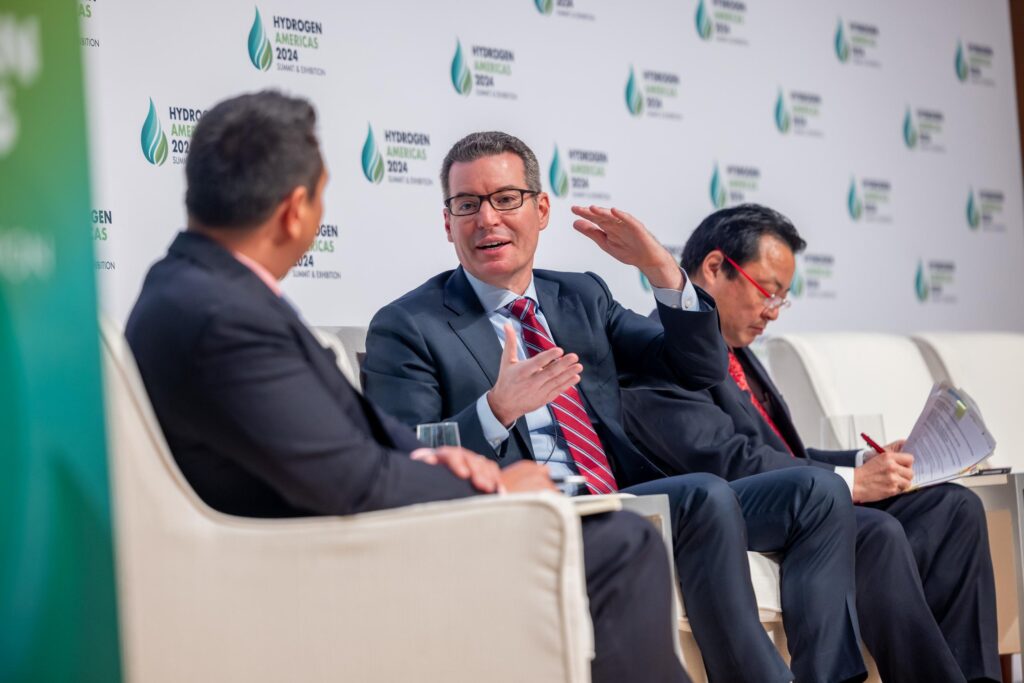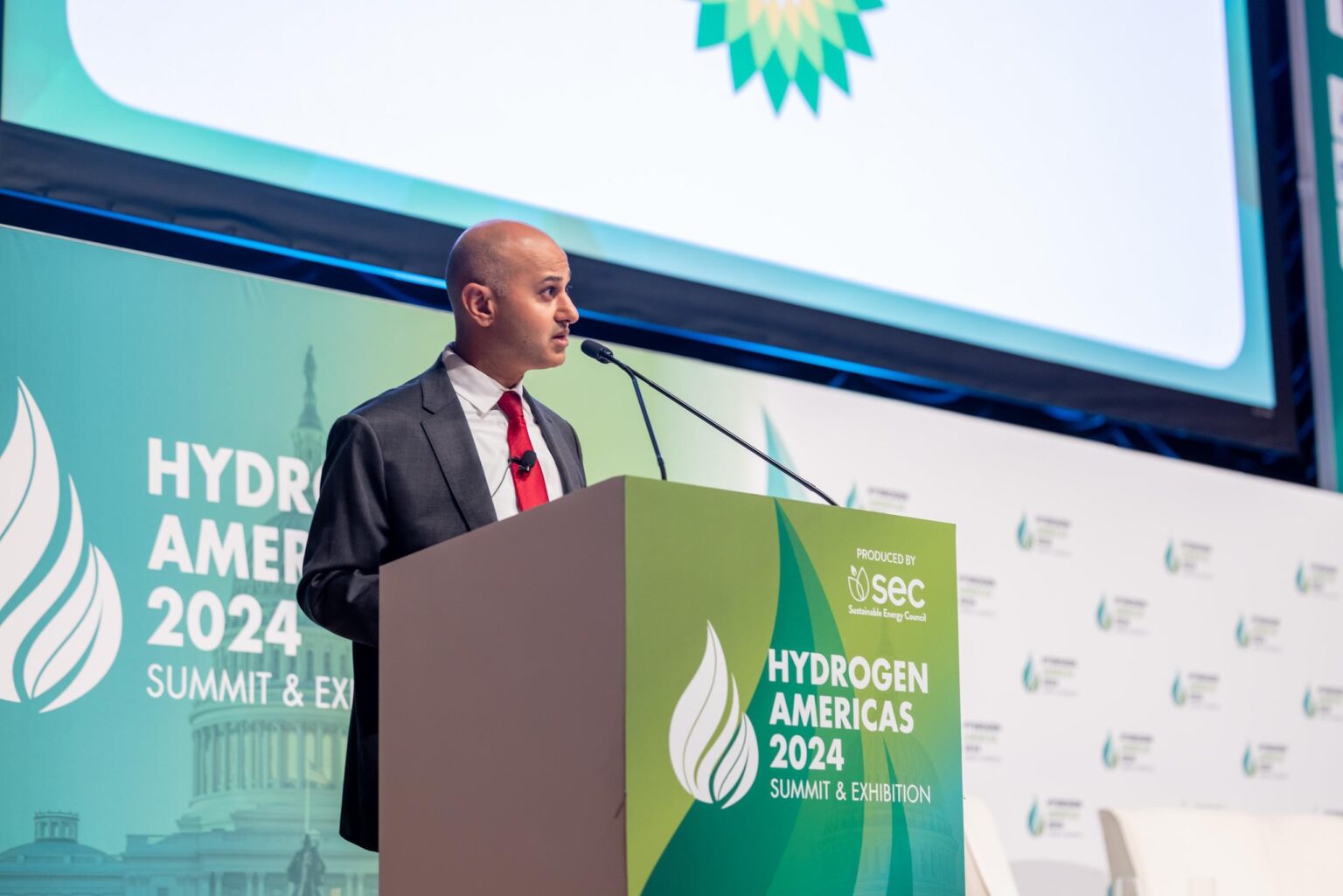Less than two years after securing generous subsidies in President Joe Biden’s landmark climate legislation, some of America’s largest oil and gas companies are directing their advocacy toward shaping one of the law’s obscure but potentially lucrative provisions: a tax credit for hydrogen production.
The hydrogen tax credit – known among advocates and industry players as “45V” for the section of the Inflation Reduction Act (IRA) that created it – felt at times as if it were the sole focus of the Hydrogen Americas Summit, a two-day industry confab held June 11-12, that wrapped up yesterday in Washington, D.C.
“We’re all talking about 45V, the hydrogen production tax credit, and for good reason,” Amanda Leland, executive director of the Environmental Defense Fund (EDF), told attendees on the first day of the conference. “It could be the most important policy incentive globally to kickstart the new clean hydrogen economy.”
Subscribe to our newsletter
Stay up to date with DeSmog news and alerts
In draft guidance published last December, the Treasury Department and the IRS proposed awarding the most valuable hydrogen tax credits only to projects that are generated using renewable energy, such as wind and solar, and that also meet other conditions designed to make sure that production actually lowers greenhouse gas emissions.
Hydrogen derived from fossil fuels – primarily natural gas but also coal – makes up more than 90 percent of global hydrogen production. Much of what the fossil fuel industry touts as “clean” hydrogen is produced with natural gas and reliant on unproven and unrealistic promises of carbon capture and storage (CCS) to sequester the carbon dioxide generated in the process.
So-called “blue” hydrogen – created by natural gas and paired with some sort of CCS technology – also generates both emissions and leakage of methane, a greenhouse gas some 80 times more potent than carbon dioxide over a 20-year window.
As the Biden administration works to finalize the parameters of the tax credit, ExxonMobil, BP, and other major oil and gas companies are pushing for a “technology neutral” approach that would allow them to cash in on the hydrogen tax incentives while continuing to produce hydrogen using natural gas – rather than shifting toward genuinely zero-emissions sources of energy like wind or solar.
Of course, that’s not exactly how they phrase it.
“At BP, we believe it is crucial to recognize the role of multiple technologies and what [impact] they could have in helping the world decarbonize,” BP’s Rushabh Shah said in a speech that kicked off the conference’s networking lunch event, which was sponsored by BP.
“Evolution can be unpredictable, and we cannot say with certainty what the future of hydrogen will look like. For that reason, policy must be technology neutral to enable society to adopt the full range of innovations necessary for an effective transition,” Shah said.
Approached by DeSmog after his remarks, Shah, the director of the company’s Midwest Hydrogen and CCS business, declined to be interviewed. But his comments reflected not only BP’s public stance but also that of other fossil fuel giants.
During a fireside chat panel earlier in the day, Dan Holton, an executive at Exxon’s Low Carbon Solutions division, similarly urged federal regulators to take “a technology agnostic approach” to defining the terms of the 45V tax credit – a euphemism for treating hydrogen produced with natural gas as favorably as “green” hydrogen generated by renewable sources.

“When they talk about [being] ‘agnostic to the technology,’ it’s because … they want to use natural gas to produce the hydrogen,” Robert W. Howarth, a professor at Cornell University’s Department of Ecology and Evolutionary Biology and co-author of a foundational 2021 study on the climate impact of hydrogen production, told DeSmog.
“They think if they can keep their thumb on the scale enough, they’ll get the accounting to meet the legal guidelines.”
Demands Cloaked in ‘Clean’ Language
Most speakers at this week’s hydrogen summit worked for companies and organizations that sponsored the conference, such as gas producer Air Products, green hydrogen developer Electric Hydrogen, and the EDF.
Holton of Exxon – a bronze-level event sponsor – took the stage on the first day of the conference to warn that his company might not move forward with its “world-scale hydrogen facility” at a refinery in Baytown, Texas, near Houston, without a hydrogen tax credit that caters to the interests of the oil and gas industry.
“There are still a number of pieces that need to come into play before [the] final investment decision” at Baytown, Holton said. “The most important one is really getting policy clarity … especially around the ability to use the differentiated natural gas” as a source of energy for producing hydrogen.
Exxon’s hydrogen efforts at its Baytown facility are anchored on the promise of blue hydrogen – a methane-leaking and natural gas-reliant energy source that is a far cry from the clean future conveyed in the company’s press releases and social media.
Because it is created using natural gas, the production of blue hydrogen generates carbon dioxide, meaning the viability of blue hydrogen as a tool for decarbonization relies on industry promises about CCS – technology that remains ineffective and insufficient. (It also remains heavily subsidized, thanks to generous tax credits and other incentives in the IRA and the Bipartisan Infrastructure Law. CCS sits alongside hydrogen as another pillar of Exxon’s “low-carbon solutions” business.)
Effective carbon capture is “just really difficult, and I see no reason to think that’s going to get better with time,” said Cornell’s Howarth. “There’s no evidence of that. If you’ve been trying for 40 years and you’ve never done it well yet, what makes you think you’re going to do it well tomorrow?”
Nevertheless, Exxon is also lobbying the European Commission to weaken EU hydrogen requirements to allow for greater reliance on blue hydrogen, as DeSmog previously reported.
Perhaps it’s no surprise that oil and gas companies would rather scrap the color distinctions entirely in favor of a simpler equation: hydrogen equals clean.
“It’s not about the colors. It’s not about a certain technology or a certain platform,” Holton said. “It’s all about getting the carbon intensity down. And that is very consistent with our philosophy on how to make this whole thing work in terms of getting the world to net zero.”
It’s also consistent with Exxon’s desire to leverage the hydrogen tax credit and other federal subsidies to make its existing business model as profitable as possible.
“This need to see clarity on 45V, especially the differentiated natural gas and being able to include that in the 45V . . . is what it’s going to take to make the supply side for ExxonMobil work on this project,” Holton said.
Exxon reported $36 billion in profits last year.
Intense Regulatory Advocacy
Last December, DeSmog and OpenSecrets reported that fossil fuel lobbying on hydrogen issues skyrocketed following the passage of the climate and infrastructure laws.
That trend has only continued. In the first quarter of 2024 alone – the latest period for which figures are available – Chevron, Exxon, BP, and their subsidiaries together spent more than $4.9 million lobbying, according to filings collected by OpenSecrets. Each firm reported spending at least some of that money lobbying federal regulators about hydrogen policy or the 45V credit specifically. Each firm also sponsored the Hydrogen Americas summit.
“One of the things about the advocacy is that it’s shifted from being advocacy of the legislative branch to more regulatory-based advocacy,” Brian Foody, president and CEO of the hydrogen producer Iogen, noted during the conference. “There’s been intense advocacy taking place at the regulatory level.”
With billions of dollars riding on the Biden administration’s final tax credit rules, that advocacy looks set to continue.
“Hydrogen is here. Hydrogen is happening,” BP’s Shah told conference attendees. “We believe we’re uniquely positioned to make it an inflection point, something that changes the trajectory of the future evolution of this industry.”
But, Shah added, “companies like BP cannot make hydrogen happen alone. We need sound policy to help us build this future.”
If the Hydrogen Americas conference is any guide, however, “sound policy” sounds a lot like business as usual.
Subscribe to our newsletter
Stay up to date with DeSmog news and alerts






